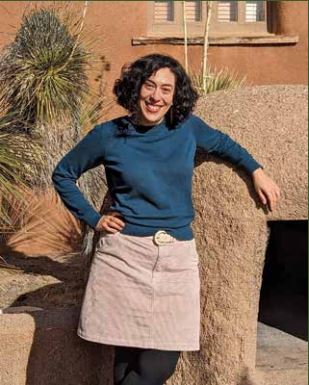Tribal Collaborations: Connecting Place and the Public

New on the job, Katrina Gallegos, site manager of Jemez and Coronado historic sites, is looking forward to putting into practice her passion for preserving and protecting the land.
Gallegos hails from the Cinco Puntos/Atrisco neighborhood in Albuquerque’s South Valley, where she served as a water commissioner helping farmers and ranchers in the South Valley Regional Acequia Association. She “still walks the ditch banks of the acequias with my mother and nephew,” she says, “admiring the beauty of the countryside and the noisy Sandhill Cranes that make life unique and worth preserving.”
Last May, after receiving her master’s degree in museum studies from Baylor University in Waco, Texas, Gallegos says she started searching for jobs where she could “preserve and promote history and culture. When I saw the position at Coronado and Jemez, I knew it aligned with my goal of promoting New Mexican history.”
Gallegos is currently overseeing a project funded by the state legislature to rewrite and install interpretive signage throughout the Pueblo ruins at Jemez, which is also a National Historic Landmark. And since a story (and in this case, the signage) requires a knowledgeable storyteller, Gallegos is collaborating with Jemez Pueblo members in developing the narrative. Other Jemez site staff, who are themselves members of the Pueblo, are also participating.
Gallegos would like to build upon this partnership with the Pueblo as a model to create new programs. Two previously successful programs from 2012 and 2014 are serving as inspiration for the new ones.
The 2012 program, Stories from the Land, brought children from the Jemez Pueblo Community Library to the historic site for a weeklong summer reading and writing program. While there, Pueblo students and teachers shared stories of their culture and upbringing with one another. The project was conceived as a way to pass Native traditions to younger generations of tribal members.
In 2014, the Elders in Residence program engaged Jemez elders to provide tours and share personal stories about the site with the general public. Made possible by a grant from the New Mexico Historic Preservation Division, the six-week summertime initiative featured a different elder each week, powerfully connecting visitors with more than an abandoned ruin, but with a thriving tribal community.
Both programs were a huge hit, increasing visitor attendance over 30%. But when the funding for Elders in Residence ended, so did the program. Now, Gallegos is seeking funding to bring a similar program back to Jemez. She has ideas to expand it to Coronado Historic Site as well.
New Mexico Historic Sites Deputy Director Matt Barbour, the previous Jemez site manager who implemented the programs, describes their importance in engaging and educating visitors: “Not every visitor to the site is able to get a personal tour with a ranger. Most have a [printed] trail guide. A good trail guide, mind you—but not a person. As a result, things get misinterpreted, and sometimes people become disengaged…the trail guide lacks the human element.”
For Gallegos, gaining private support for tribe-inspired public education programs is vital to the public’s understanding of the significance, in history and today, of Jemez. “It is through stories that we connect with a place,” she says. “These hoped-for programs, in collaboration with the Pueblo’s artists and cultural leaders, will continue to spark new and vibrant conversations with visitors to Jemez Historic Site.”
This article and image are from the Museum of New Mexico Foundation’s Member News Magazine.


Connect